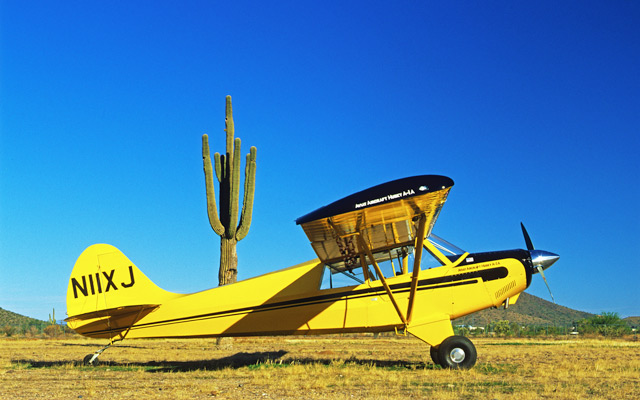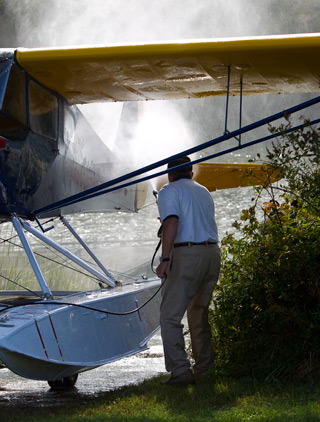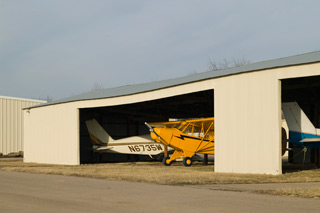Ownership: Tube and fabric 101
Tips for the prospective owner

There’s just something about a tube-and-fabric airplane that captures the imagination. Whether it’s a bright-yellow Piper Cub or a bright-red-and-white American Champion Decathlon, fabric airplanes evoke a time when flight was, well, fun. Not to mention more affordable. It’s no wonder we love ’em so much.
Certified fabric airplanes are still being made—albeit in much smaller numbers than in the days when Piper rolled them out of the factory. Numerous homebuilt/Experimental models incorporate tube-and-fabric designs. Vintage and antique tailwheel aircraft are among the most affordable out there—but if all you’ve ever known is the cocoon of an all-metal aircraft, you might be reluctant to explore ownership of so-called rag-wing airplanes. Fabric? Tube?
These airplanes have a fuselage constructed of welded steel tubes. The wings may be pieces of wood—usually spruce—glued together. Or, if built later than the 1940s, the spars and ribs likely were metal.
The frame is covered by fabric. Piper PA–18s, for example, emerged from the factory wearing Grade A cotton fabric tested to withstand a minimum of 80 pounds per square inch. With the advent of more durable, longer-lasting synthetic blends like Ceconite or Poly-Fiber, few aircraft still flying today continue to wear cotton coats.
 Classic and antique aircraft got coats of plasticized lacquer called dope, a flammable material that served to tighten the fabric and provide some protection from the elements; paint was applied over the dope. That was then. Now, aircraft owners can choose from among several systems—governed by supplemental type certificates—for covering and finishing fabric airplanes. One of these is the Poly-Fiber system (www.polyfiber.com), which AOPA Pilot chose in 1998 for the restoration of our Timeless Tri-Pacer sweepstakes airplane. Another is the Ceconite system (www.ceconite.com). Both use synthetic fabrics that are shrunk by heat rather than dope and then finished with several coats of protective materials that are not flammable.
Classic and antique aircraft got coats of plasticized lacquer called dope, a flammable material that served to tighten the fabric and provide some protection from the elements; paint was applied over the dope. That was then. Now, aircraft owners can choose from among several systems—governed by supplemental type certificates—for covering and finishing fabric airplanes. One of these is the Poly-Fiber system (www.polyfiber.com), which AOPA Pilot chose in 1998 for the restoration of our Timeless Tri-Pacer sweepstakes airplane. Another is the Ceconite system (www.ceconite.com). Both use synthetic fabrics that are shrunk by heat rather than dope and then finished with several coats of protective materials that are not flammable.
Now that you understand a bit more about fabric airplanes, here’s what seasoned owners think you should know if you’re contemplating a purchase.
1. Build your support network before you buy. What kind of airplane are you shopping for? Is there someone at your home airport who has first-hand knowledge of the model from an owner’s or mechanic’s perspective? If not, look to type clubs or owners’ groups, which offer a huge amount of information. They can be a valuable resource for locating a potential purchase, as their members will frequently post for-sale ads within the group. Type clubs can point you to sources for parts and maintenance. AOPA’s extensive list of type clubs is available online.
Joe Abrahamson of Phoenix, Arizona, owns a 1949 Aeronca Sedan—his fourth Aeronca. When he purchased his first, he recalls, “There’s no way to buy experience, and when I got into this I had a mentor who was an old-school guy. He knew pretty much everything about these.” Find someone with experience, Abrahamson says. He cites the National Aeronca Association for its knowledge and expertise, and says of its online bulletin board, “Anybody on the Internet can look at it. If you have a question, you’ll have an answer in a couple hours maximum.”
2. Don’t gloss over the prebuy. A thorough prepurchase inspection is a smart move for any aircraft purchase—metal or fabric.
Casey Hansen of Cedar Rapids, Iowa, purchased a tailwheel 1950 Piper Pacer in April 2012, and says a friend who owned a Piper Tri-Pacer provided invaluable insights into tube-and-fabric airplanes in general and the quirks of the short-wing Pipers in particular. If you don’t happen to have a knowledgeable friend, here’s where type-club connections can help you locate people who own, fly, or work on these airplanes.
The older the aircraft, the more history you’ll need to investigate, Hansen points out. How did the previous owner(s) care for the airplane? Inspecting the tubes is a necessity; check for corrosion of the tubes themselves as well as rust where fabric might wrap around them. Inspect wood spars and ribs for dry rot and cracks. 
A fabric airplane may have been re-covered several times, and you’ll want to investigate how this was done and what materials were used.
“If you’re the least bit concerned about it, pull [an] inspection cover on the bottom of the wing,” Abrahamson advises. Position the airplane in strong direct sunlight, remove an inspection cover, and look inside. “If it’s as dark as can be inside, you’re good,” he says—no light is penetrating the fabric. But if you see pinholes of light, that means light is getting into the fabric and it will not last as long as it should, he says. If the airplane needs to be re-covered, you should factor that into the purchase price.
3. Tubes and fabric are stronger than you think. Anne Scheer Wright of Saline, Michigan, acquired an Experimental Super Cub in 2002, and admits that at that time, “I didn’t really trust fabric, yet.” She attended an Experimental Aircraft Association workshop on stitching, ironing, and painting fabric. “At the end of the class we had covered an aileron from a DC–3,” she says. “And for our class picture we all stood on it.” With a dozen people standing on the aileron, “I kind of expected to go through it,” she says. “It gave just a little bit, the tiniest little bit, and it was as strong as could be.”
The cottons and linens used in the 1930s and 1940s had a lifespan of about five years, but the newer synthetic materials have a longer life, particularly if kept out of the sun.
And tubes? They’re pretty tough too, so long as there’s no corrosion. Melissa Smith Abner of Nashville, Tennessee, has flown aerobatics in her 1946 Taylorcraft and says her instructor, a world champion, “would rather do aerobatics in a tube airplane than in a new composite.”
4. Keep it cool and dry. If corrosion eats at unprotected metal aircraft, the sun’s punishing ultraviolet rays will do the worst damage to fabric airplanes. You’ll want a hangar or a shadeport at the very least (and only if you live in a dry climate), according to the owners interviewed for this article. That’s not to say moisture won’t affect these aircraft—it can and will, particularly if moisture is allowed to collect in the tail—the lowest point—of your beloved Champ or Chief.
5. Routine care: Wash and wax. As mentioned, keep your airplane dry and out of the sun’s light. Clean off insects between flights; apply wax to leading edges and control surfaces. Mark Coleman of Dearborn, Michigan, says he uses Meguiar’s products on the Great Lakes 2T-1A-2 biplane he flies for fun, as well as the Piper PA–25-235 Pawnee he flies for the Adrian Soaring Club.
6. Don’t forget the fabric at annual. This is the time to take another look at your airplane’s fabric to see how it’s holding up. If there are any doubts, ask your mechanic to perform a punch test on the material. A hole means the fabric has deteriorated and you’re looking at replacement.
7. Handle with (some) care. Rugged little fabric taildraggers have withstood generations of pilots who bounced and ground looped them during training. Even so, they won’t put up with too much mishandling. “You can’t grab it anywhere,” says Casey Hansen. “If you go to fly-ins, you have to watch kids because they like to climb on things. In general, you have to be really cognizant that it’s a living, breathing kind of skin on the airplane, and it’d be unfortunate if a kid tried to climb on that tail.”
8. Enjoy it. “Wash it and wax it and fly it,” Anne Scheer Wright advises. “On a warm day [when] I go out to the hangar and I open the door, she smells so good—there is nothing like the smell of a fabric airplane on a warm day.”
Email [email protected].


